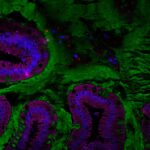Link to Pubmed [PMID] – 28890156
Link to DOI – 10.1016/j.bbi.2017.08.027
Brain Behav Immun 2018 Jan; 67(): 218-229
The mammalian fetus develops in a largely sterile environment, and direct exposure to a complex microbiota does not occur until birth. We took advantage of this to examine the effect of the microbiota on brain development during the first few days of life. The expression of anti- and pro-inflammatory cytokines, developmental cell death, and microglial colonization in the brain were compared between newborn conventionally colonized mice and mice born in sterile, germ-free (GF) conditions. Expression of the pro-inflammatory cytokines interleukin 1β and tumor necrosis factor α was markedly suppressed in GF newborns. GF mice also had altered cell death, with some regions exhibiting higher rates (paraventricular nucleus of the hypothalamus and the CA1 oriens layer of the hippocampus) and other regions exhibiting no change or lower rates (arcuate nucleus of the hypothalamus) of cell death. Microglial labeling was elevated in GF mice, due to an increase in both microglial cell size and number. The changes in cytokine expression, cell death and microglial labeling were evident on the day of birth, but were absent on embryonic day 18.5, approximately one-half day prior to expected delivery. Taken together, our results suggest that direct exposure to the microbiota at birth influences key neurodevelopmental events and does so within hours. These findings may help to explain some of the behavioral and neurochemical alterations previously seen in adult GF mice.


